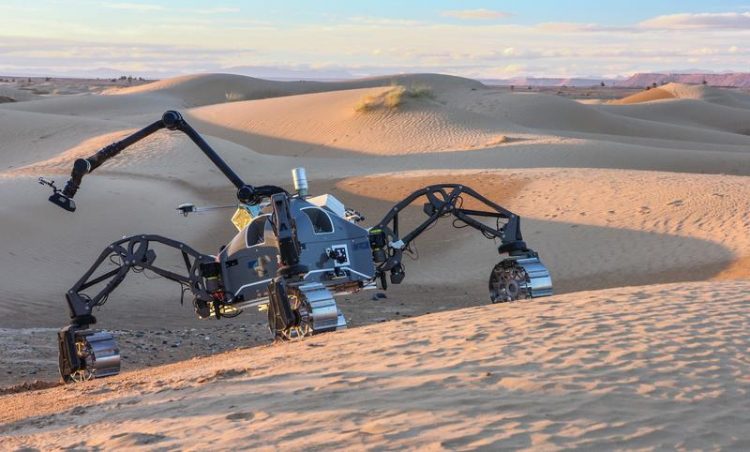Mission completed – EU partners successfully test new technologies for space robots in Morocco

The hybrid walking and driving rover "SherpaTT" in the desert of morocco. DFKI GmbH, photo: Florian Cordes
Close to the border with Algeria, the Erfoud region in Morocco – known to tourists for its impressive sand dunes – offered ideal conditions for the four-week field test campaign. With its barren outcrops and reddish ridges the landscape is remarkably similar to the topography of Mars.
There, the European research team was able to test robots, sensors and software under conditions much closer to the real conditions of future planetary exploration missions than those that can be found in the lab.
“Only through such field tests we can have high confidence that the software and hardware we developed will work as planned under the harsh environmental conditions that prevail on Mars and Moon. We do test software and hardware in labs and in computer simulations.
In these we simulate what we imagine, but reality provides for unforeseen situations. The variability that nature brings – from lighting conditions to the shapes of the landscape, to the structures of the sand and rocks – cannot be simulated reliably, it can only be experienced in field tests” says Gianfranco Visentin, Head of Automation and Robotics at the European Space Agency (ESA) and coordinator of the EU project PERASPERA.
In the PERASPERA project, the European Space Agency (ESA), the German Aerospace Center (DLR), and the national space agencies of France, Spain, Italy and Great Britain work together to develop the research roadmap for the EU’s Strategic Research Cluster (SRC) on Space Robotics Technologies and to oversee the implementation of the various research projects funded by this program.
An important part of the SRC roadmap are extensive tests and evaluation measures for the technologies developed in various sub-projects. This includes the field tests in Morocco, which were organized by DFKI's Robotics Innovation Center as part of the FACILITATORS project (led by the Spanish company GMV).
The first two weeks of the Morocco campaign were used to set up and prepare all hardware and software systems in a workshop near the base-camp in Erfoud. In addition, a detailed digital elevation map of the test area was prepared using a flight drone from ESA. At the end of November, the scientists finally set up their field camp in the desert near Rissani, about 30 km southwest of Erfoud.
There, they tested the software for autonomous robot behaviour and data fusion. These systems had been developed as part of the EU projects ERGO – coordinated by GMV from Spain – and InFUSE, coordinated by Space Applications from Belgium.
The robotic platform used in the tests was the SherpaTT robot provided by DFKI. This hybrid robot with four “wheeled” legs can drive and walk. It represents a new type of robots for space exploration. In addition, a pair of “classic” 4-wheeled rovers, MINNI and MANNA provided by CNRS-LAAS (Toulouse, France), as well as the Handheld Central Rover Unit (HCRU), a sensor module developed by the DLR institute in Oberpfaffenhofen, Germany, were used in the field trials.
Inspired by planetary exploration scenarios such as the NASA Mars Sample Return Mission, the SherpaTT rover used the new software to perform an autonomous long-distance exploration mission. To take a soil sample at a remote destination, the rover covered a distance of more than 1.3 km, traversing wide plains and finding its way around steep cliffs and deep gorges in the Moroccan desert landscape.
The results of the tests and the data collected by the rovers in Morocco represent great success and a significant test dataset for analogue simulations. During the field tests, the project partners could demonstrate not only that the developed software modules work under Mars-like conditions, but also compile a valuable database for further research work.
The successfully tested “Space Robotics Technologies” will now serve as core components for more complex robotics applications, which are planned to be developed from 2019 to 2021 in a second series of EU-funded R&D projects.
Further information:
Strategic Research Clusters (SRC) on Space Robotics Technologies/PERASPERA: www.h2020-peraspera.eu/
ERGO: www.h2020-ergo.eu/
ESROCOS: www.h2020-esrocos.eu/ ; www.dfki.de/robotik/en/research/projects/esrocos.html
FACILITATORS: www.h2020-facilitators.eu ; www.dfki.de/robotik/en/research/projects/facilitators.html
INFUSE: www.h2020-infuse.eu ; www.dfki.de/robotik/en/research/projects/infuse.html
Photos:
Photos are available under https://cloud.dfki.de/owncloud/index.php/s/rR3HgDdByYWZojg for download. You can use these images when citing the source „DFKI GmbH“.
Contact:
German Research Center for Artificial Intelligence (DFKI GmbH)
Robotics Innovation Center
Dr.-Ing. Thomas Vögele
Mail: Thomas.Voegele@dfki.de
Phone: +49 30 23895 1860
Press contact:
German Research Center for Artificial Intelligence (DFKI GmbH)
Unternehmenskommunikation Bremen
Mail: uk-hb@dfki.de
Phone: + 49 421 178 45 4180
Media Contact
All latest news from the category: Physics and Astronomy
This area deals with the fundamental laws and building blocks of nature and how they interact, the properties and the behavior of matter, and research into space and time and their structures.
innovations-report provides in-depth reports and articles on subjects such as astrophysics, laser technologies, nuclear, quantum, particle and solid-state physics, nanotechnologies, planetary research and findings (Mars, Venus) and developments related to the Hubble Telescope.
Newest articles

First-of-its-kind study uses remote sensing to monitor plastic debris in rivers and lakes
Remote sensing creates a cost-effective solution to monitoring plastic pollution. A first-of-its-kind study from researchers at the University of Minnesota Twin Cities shows how remote sensing can help monitor and…

Laser-based artificial neuron mimics nerve cell functions at lightning speed
With a processing speed a billion times faster than nature, chip-based laser neuron could help advance AI tasks such as pattern recognition and sequence prediction. Researchers have developed a laser-based…

Optimising the processing of plastic waste
Just one look in the yellow bin reveals a colourful jumble of different types of plastic. However, the purer and more uniform plastic waste is, the easier it is to…


